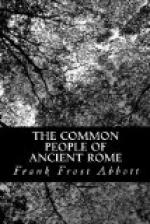We have tried to bring out the characteristic features of this romance in order that we may see what the essential elements are of the problem which faces one in attempting to explain the origin of the type of literature represented by the work of Petronius. What was there in antecedent literature which will help us to understand the appearance on Italian soil in the first century of our era of a long erotic story of adventure, dealing in a realistic way with every-day life, marked by a satirical tone and with a leaning toward the prose-poetic form? This is the question raised by the analysis, which we have made above, of the characteristics of the story. We have no ambitious hope of solving it, yet the mere statement of a puzzling but interesting problem is stimulating to the imagination and the intellect, and I am tempted to take up the subject because the discovery of certain papyri in Egypt within recent years has led to the formulation of a new theory of the origin of the romance of perilous adventure, and may, therefore, throw some light on the source of our realistic novel of every-day life. My purpose, then, is to speak briefly of the different genres of literature of the earlier period with which the story of Petronius may stand in some direct relation, or from which the suggestion may have come to Petronius for his work. Several of these lines of possible descent have been skilfully traced by others. In their views here and there I have made some modifications, and I have called attention to one or two types of literature, belonging to the earlier period and heretofore unnoticed in this connection, which may help us to understand the appearance of the realistic novel.
It seems a far cry from this story of sordid motives and vulgar action to the heroic episodes of epic poetry, and yet the Satirae contain not a few more or less direct suggestions of epic situations and characters. The conventional motif of the story of Petronius is the wrath of an offended deity. The narrative in the Odyssey and the AEneid rests on the same basis. The ship of their enemy Lichas on which Encolpius and his companions are cooped up reminds them of the cave of the Cyclops; Giton hiding from the town-crier under a mattress is compared to Ulysses underneath the sheep and clinging to its wool to escape the eye of the Cyclops, while the woman whose charms engage the attention of Encolpius at Croton bears the name of Circe. It seems to be clear from these reminiscences that Petronius had the epic in mind when he wrote his story, and his novel may well be a direct or an indirect parody of an epic narrative. Rohde in his analysis of the serious Greek romance of the centuries subsequent to Petronius has postulated the following development for that form of story: Travellers returning from remote parts of the world told remarkable stories of their experiences. Some of these stories took a literary form in the Odyssey and the Tales




